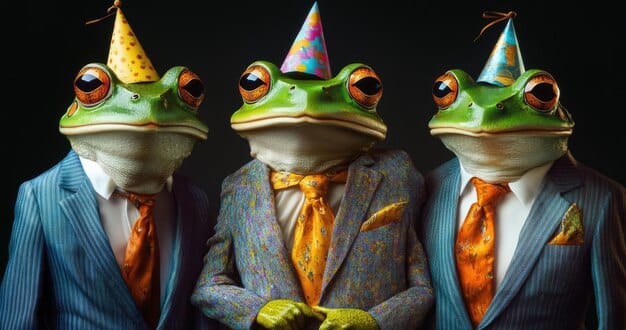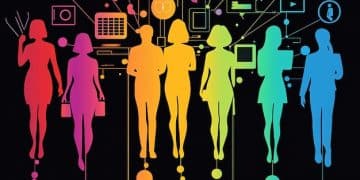The Evolution of Memes: Tracing Their Impact on Digital Culture

Anúncios
The evolution of memes from simple internet jokes to potent forms of cultural commentary reflects the dynamic nature of online communication and its impact on society.
Anúncios
The digital landscape is constantly evolving, and one of its most captivating transformations is the journey of the evolution of memes: from viral jokes to cultural commentary. What started as simple, humorous internet content has grown into a complex language of its own, shaping online discourse and reflecting cultural shifts.
Understanding the Genesis of Internet Memes
The meme, as we know it today, began its journey in the obscure corners of the internet. Initially, they were simple, often nonsensical jokes shared within niche communities. However, their ability to spread rapidly and evolve with each iteration quickly transformed them into a cultural phenomenon.
Anúncios
Early Days: The Birth of Viral Jokes
The early internet was a breeding ground for nascent meme culture. Simple images and phrases, often spread through email chains and early forums, began to take on new meanings as they were remixed and recontextualized by different users.
- Kilroy Was Here: One of the earliest examples of a meme-like phenomenon, predating the internet but showcasing the human tendency to spread and adapt simple symbols.
- Dancing Baby: A rudimentary CGI animation that became one of the first viral video sensations, demonstrating the power of visual content to capture collective attention.
- All Your Base Are Belong to Us: A poorly translated video game cutscene that became an iconic catchphrase, highlighting the role of humor and shared in-jokes in meme culture.
These early examples laid the foundation for the meme ecosystem, demonstrating the potential for simple ideas to spread rapidly and evolve through collective participation.

In conclusion, the genesis of internet memes can be traced back to simple, shareable jokes that quickly gained traction and evolved through collective participation. These early examples set the stage for the complex and dynamic meme culture we see today.
The Rise of Image Macros and Catchphrases
As the internet matured, so did the meme. Image macros, combining humorous pictures with witty captions, became a dominant form. Catchphrases, often taken from movies, TV shows, or viral videos, provided ready-made templates for expressing shared experiences and emotions.
Image Macros: A Picture is Worth a Thousand Laughs
Image macros provided a versatile format for expressing humor and commentary. By pairing relatable images with short, punchy captions, they could convey complex ideas in an easily digestible format.
- LOLcats: Pictures of cats with humorous captions, often written in intentionally poor grammar, became a quintessential example of early internet humor.
- Advice Animals: A series of image macros featuring stock photos of animals paired with advice, often satirical or ironic.
- Rage Comics: Simple, hand-drawn comics expressing common frustrations and annoyances, providing a cathartic outlet for everyday experiences.
These image macros became building blocks for online communities, allowing people to connect over shared humor and experiences.
In conclusion, the rise of image macros and catchphrases marked a significant step in the evolution of memes, providing versatile formats for expressing humor and commentary in an easily digestible and shareable manner.
Memes as a Form of Social Commentary
Memes have evolved beyond simple jokes and catchphrases to become a potent form of social commentary. They provide a platform for individuals to express their opinions, satirize current events, and challenge prevailing norms.
Satire and Political Discourse
Memes have become a powerful tool for political satire, allowing individuals to express their opinions and criticize political figures and ideologies in a humorous and accessible way.
- Doge: A Shiba Inu dog with internal monologue captions in Comic Sans font, often used to satirize internet culture and popular trends.
- Distracted Boyfriend: A stock photo depicting a boyfriend distracted by another woman, used to comment on societal issues and political debates.
- Woman Yelling at a Cat: A combination of two separate images, used to depict humorous arguments and misunderstandings.
These memes provide a unique perspective on social issues, often cutting through political rhetoric and offering sharp critiques of contemporary society.
In conclusion, memes have become a powerful tool for social commentary, providing a platform for individuals to express their opinions, satirize current events, and challenge prevailing norms in a humorous and accessible way.
The Impact of Memes on Popular Culture
Memes have not only influenced online culture but have also permeated mainstream media, impacting language, fashion, and even political campaigns. Their ability to capture attention and spread rapidly has made them a powerful force in shaping popular culture.
Crossovers into Mainstream Media
Memes have frequently crossed over into mainstream media, appearing in commercials, TV shows, and even political campaigns. This demonstrates their cultural relevance and ability to resonate with a broad audience.
The integration of memes into mainstream media reflects their increasing acceptance as a legitimate form of communication and entertainment. Brands and political campaigns often leverage memes to connect with younger audiences and create a sense of authenticity.
In conclusion, the impact of memes on popular culture is undeniable, with their influence extending beyond the online world and into mainstream media, shaping language, fashion, and even political discourse.
The Dark Side of Memes: Misinformation and Harmful Content
While memes can be a force for good, they also have a dark side. Misinformation, hate speech, and harmful content can spread rapidly through meme culture, posing a threat to vulnerable individuals and society as a whole.
Combating Misinformation and Hate Speech
The spread of misinformation through memes is a serious concern, as false or misleading information can easily go viral and influence public opinion. Similarly, hate speech and harmful content can spread rapidly, targeting vulnerable individuals and communities.
Platforms are working to combat the spread of misinformation and harmful content through various measures, including content moderation, fact-checking, and algorithm adjustments. However, the sheer volume of memes created and shared online makes it difficult to effectively monitor and regulate all content.
In conclusion, the dark side of memes highlights the need for vigilance and critical thinking when engaging with online content. Combating misinformation and hate speech requires a collaborative effort from platforms, users, and policymakers to promote responsible and ethical meme culture.
Future Trends in Meme Culture
The evolution of memes is far from over. As technology advances and online culture continues to evolve, new trends and formats are emerging, shaping the future of meme culture.
AI-Generated Memes and Interactive Content
Artificial intelligence is playing an increasingly significant role in meme culture, with AI-generated memes and interactive content becoming more prevalent. AI algorithms can analyze trends and generate customized memes, catering to specific interests and demographics.
Interactive memes, which allow users to participate and personalize content, are also gaining popularity. These formats foster a sense of community and engagement, further blurring the lines between creator and consumer.
In conclusion, the future of meme culture is likely to be shaped by technological advancements, with AI-generated memes and interactive content playing a central role. These trends will continue to evolve and adapt as online culture progresses.
| Key Point | Brief Description |
|---|---|
| 😂 Early Memes | Simple jokes like ‘Dancing Baby’ set the stage. |
| 🖼️ Image Macros | LOLcats and Advice Animals became internet staples. |
| 🗣️ Social Commentary | Memes now often satirize politics and society. |
| 🤖 AI & Memes | AI is starting to generate and personalize memes. |
Frequently Asked Questions
▼
A meme is an idea, behavior, or style that spreads from person to person within a culture. Internet memes are typically images or videos with text that are humorous or relatable.
▼
Memes become popular through rapid sharing on social media and internet forums. They often resonate with users due to their humor, relatability, or commentary on current events.
▼
Yes, memes can be used for advertising. Brands often use memes to connect with younger audiences and create a sense of authenticity. However, it’s essential to use them appropriately to avoid appearing out of touch.
▼
The future of meme culture will likely be shaped by technological advancements, with AI-generated memes and interactive content playing a significant role, leading to even more personalized content.
▼
Memes often reflect cultural shifts by satirizing current events, expressing common frustrations, and challenging prevailing norms, making them a potent tool for social commentary.
Conclusion
From their humble beginnings as simple online jokes to their current status as potent forms of social commentary, memes have undergone a remarkable evolution. As technology continues to advance, memes will undoubtedly continue to evolve, reflecting and shaping our digital culture in new and unexpected ways.





